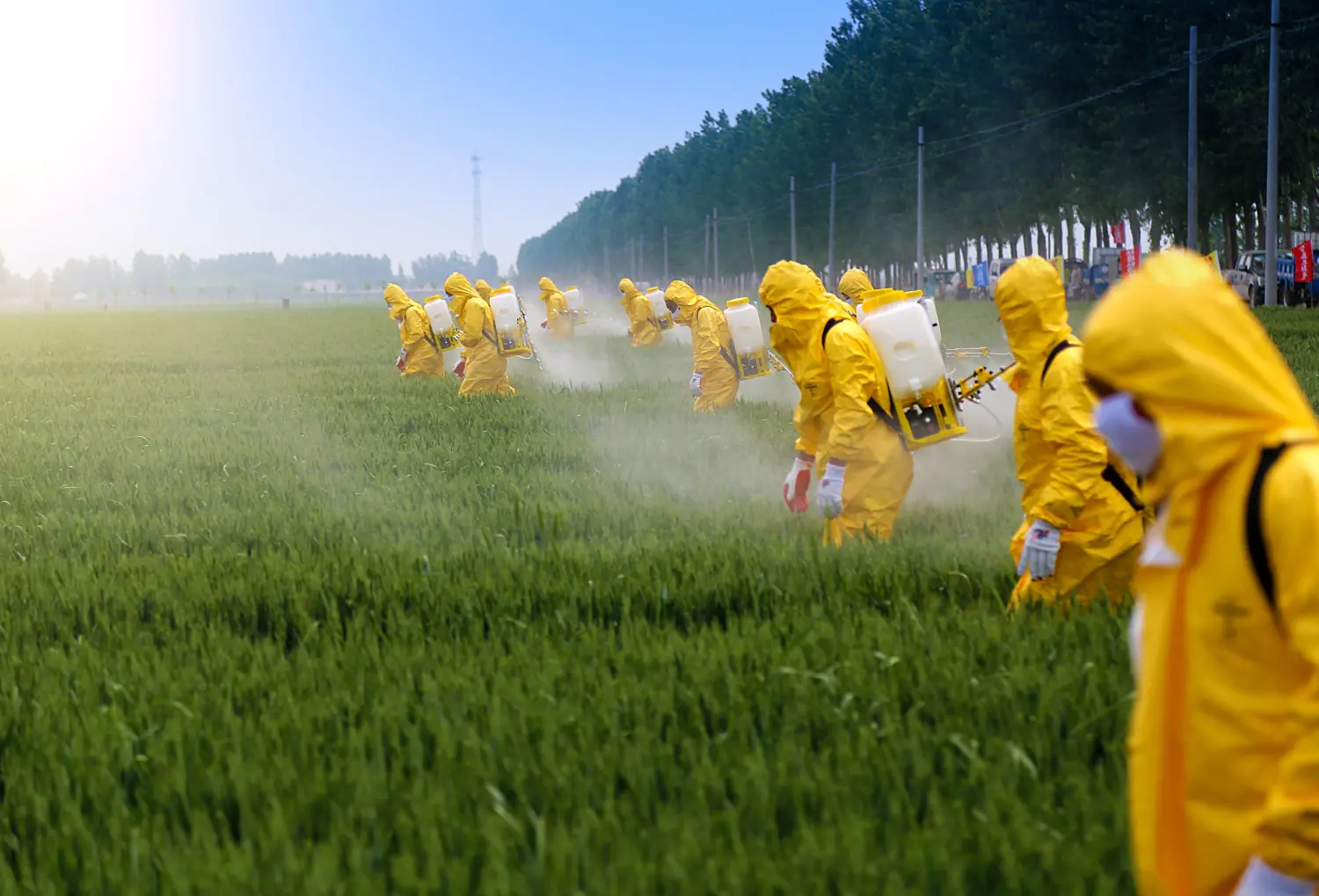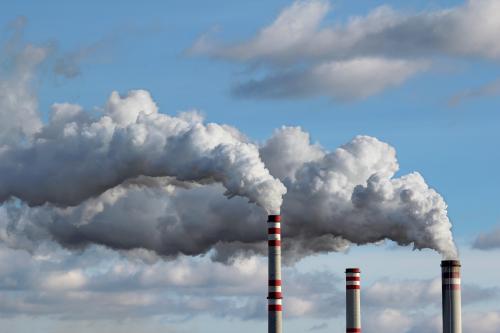Since the 1970s, the U.S. Environmental Protection Agency (EPA) has been tasked with using the best available science to regulate pesticides in order to ensure they are safe.
But a mounting body of evidence indicates that the agency long-heralded for its early decision to ban DDT has evolved into a more timid regulator that has not kept pace with the rest of the world to protect the health of people and wildlife.
That problematic trend was highlighted recently in two separate investigations by the EPA’s own watchdog. It found numerous scientific integrity and transparency failures prior to the decision to expand the use of a pesticide called dicamba that has subsequently caused damage to millions of acres of rural landscapes across the U.S. and its decision to downgrade the cancer classification of a pesticide called 1,3-D that is associated with serious harms to farmworkers.12
My research has found that there has been a significant decline in the health-protective actions taken by the EPA’s pesticide office over the years.3 In this article, I outline how our regulators’ failings are negatively impacting not only public health but also the nation’s agricultural economy. This is particularly evident when comparing U.S. pesticide regulations to other agricultural economies around the world and the barriers to trade that this can impose. I also propose potential policy solutions to ensure the EPA’s pesticide office is once again following the best-available science to fulfill its stated mission “to protect human health and the environment.”4
Out-of-the-Gate Success Runs Out of Steam
Pesticide regulation in the United States has an inspiring origin: Following a public health and environmental crisis spurred by the irresponsible use of pesticides, Rachel Carson’s 1962 book “Silent Spring” defied expectations to become a global call to action. The chilling story exposing the long-term environmental costs of the escalating use of unregulated pesticides inspired the formation of the EPA and initiated a legislative and regulatory framework on pesticides that was copied around the world. The benefits of the new regulatory framework soon became undeniable, spotlighted most notably by the fact that the American bald eagle, our national symbol, was saved from the brink of extinction.5
Yet, immediately, many companies accustomed to operating without regulatory oversight complained and fought back against even the most measured science-based rules to reduce dangerous pollution.6 Throughout the years, the intense political pressure put on the EPA’s pesticide office and the popular trend of many of the agency’s employees going to work for the pesticide industry had tangible consequences.7 The result is a pesticide regulator that has been increasingly unable to say “no” to any pesticide even when compelling independent research demonstrated the pesticide to have troubling health risks.
As a direct result of the EPA’s laissez-faire regulatory approach, in 2019 the U.S. used over 70 agricultural pesticides that were banned in the European Union, amounting to 322 million pounds used each year.8 That means over a quarter of all U.S. agricultural pesticide use was from pesticides that all EU member states have prohibited. And with more recent bans on pesticides like chlorothalonil and the EU’s new farm-to-fork strategy which aims to cut pesticide use in half by 2030, that regulatory disparity is growing significantly by the year.910
It is not just Europe that is embracing these prohibitions. The U.S. uses 26 and 40 million pounds of pesticides that Brazil and China have banned or are phasing out, respectively.11 India is currently considering banning 27 highly hazardous pesticides, like atrazine, 2,4-D, and acephate, which the U.S. uses over 100 million pounds of each year.1213 Atrazine is a known endocrine disruptor linked to fertility problems1415; 2,4-D is associated with certain cancers and birth defects in children1617; and acephate is a known neurotoxin in the same class of chemicals as those developed for use as nerve agents in World War II.18
China, Brazil, India, the EU, and the U.S. are the five largest agricultural producers in the world.19 The U.S. is now falling behind all of them when it comes to eliminating the most harmful agricultural pesticides still in use (please see Appendix Table 1 for all pesticides that the EU, Brazil and China have prohibited but the U.S. still allowed as of 2019).
Worse yet, as the other four leading agricultural producers move forward with restrictions or bans on the most toxic pesticides, the U.S. pesticide approval process has in some cases moved us backward. The use of aldicarb, one of the few pesticides designated as “extremely hazardous” by the World Health Organization and banned in 125 different countries around the world, was recently expanded by the EPA.202122 This is the same pesticide that was responsible for the largest known outbreak of food-borne pesticide illness in the U.S. when over 1,300 people fell ill after eating contaminated watermelons in the 1980s.23
A federal court subsequently struck down the EPA’s recent expanded approval of aldicarb as being unlawful,24 but the message from the agency was clear: Virtually no pesticide is too egregious for the EPA to keep it on the market.
As I detail later in this article, U.S. agricultural interests are now paying an economic price for their decades of routinely fighting back against nearly every effort to regulate even the worst pesticides. Meanwhile, other leading agricultural nations that worked to put in place commonsense measures over the years have not only better protected human and environmental health, but they have bolstered their long-term economic interests.
“Progress” is often too little or too late
It would be inaccurate to say the U.S. fails to take any steps to protect people and wildlife from these dangerous pesticides once they have been approved. In some ways we have a very robust regulatory infrastructure compared to many other countries around the world. EPA will often offer public commenting opportunities when making major pesticide decisions and the amount of analysis that goes into pesticide assessments is impressive.25 This analysis often leads to the EPA placing use restrictions on the labels of many pesticide products to, in theory, prevent people and the environment from being poisoned while still keeping products on the market. But we know that people often don’t or can’t follow these incredibly complex labels, reducing the effectiveness of such a system.26
Meanwhile, the EPA fails at taking that crucial last step of removing many dangerous pesticides from within our own borders. There are multiple reasons for this, but the biggest is the U.S. regulatory framework itself. The U.S.’s current pesticide law27 contains many barriers that make it difficult and resource-intensive to revoke the approval of a pesticide, regardless of whether the science indicates it is clearly too dangerous to use with even the strictest use directions. For example, EPA is required to explore alternatives to revoking the approval of a pesticide (even though there is no similar requirement to explore alternatives to approving a pesticide) and, above all, account for how its actions will affect the agricultural economy.28
Thus, one of the only times the EPA cancels a pesticide is when a pesticide company voluntarily requests it. In the last two decades, pesticide makers have voluntarily removed around 60 pesticides from use in the U.S., while the EPA has unilaterally removed only five.29 Pesticide makers can have multiple reasons for not wanting to keep a product registered in the U.S., and economic considerations often drive those decisions rather than public health concerns.
In the few cases when the EPA has taken action to remove a pesticide due to public health concerns, the removal was often too slow or incomplete (and only implemented after many lawsuits to force action). For example, six years after first proposing to do so, the EPA recently banned all food uses of chlorpyrifos, a pesticide known to harm the developing brains of young children, following multiple legal victories by farmworker and public health advocates.30 However, the agency has since left in place all non-food uses of the pesticide, prolonging exposure to farmworkers and nearby communities from places like golf courses, cotton fields, and Christmas tree farms. Meanwhile many states—driven by public outcry and serious concerns raised by scientists—have already moved to completely prohibit the pesticide, leaving in place a patchwork of regulations in the U.S. that benefits neither agriculture nor broader public health.
Take, also, the example of pentachlorophenol (“penta”), a pesticide used since the 1930s to preserve the wooden utility poles that hold electrical and telephone lines throughout the country. In 2015, penta was listed in Annex A of the Stockholm Convention, an international treaty designed to globally eliminate the most toxic and persistent chemicals ever used.31 The treaty has been signed and ratified by 184 countries around the world.32 The listing of penta, a potent carcinogen, on the Stockholm Convention essentially banned its use across most of the world. The U.S. is one of just a handful of countries that has not ratified this treaty and, thus, is not obligated to comply with its charge. Just last year, the EPA announced that it would finally be cancelling all uses of penta with a phaseout period of six years—to be completed in February 2027.33 When all is said and done, it will end up taking one of the richest, most powerful countries in the world 12 years just to do what the rest of the world has already achieved.
There are other examples too, including endosulfan, a chemical listed in the Stockholm Convention and banned throughout much of the world in 2011 but only phased out in the U.S. in 2016—five years later.34
Falling behind is bad agricultural policy
It should go without saying that these long delays and carve outs for certain pesticide uses prolong human exposure to chemicals that are known beyond a shadow of a doubt to harm people and the environment. But what effect does this all have on agriculture? Conventional thinking would tell us that less regulatory intervention is better for agricultural interests, yet there is very little evidence to support this.
It is hard to effectively argue that agricultural production would suffer by simply taking the worst-of-the-worst pesticides off the market, given that the four other largest agricultural economies in the world are doing just fine without those pesticides. These are our competitors in the global agricultural market and they have just as much interest as the U.S. does in keeping costs low and agricultural production high. They make it work, and we can, too. In fact, in a global economy we do ourselves a disservice by being so far out of synch with the rest of the world.
There is plenty of evidence that continuing to use pesticides that the rest of the world has shunned can negatively impact trade and lead to the loss of entire export markets for the U.S. All food commodities have maximum residue limits (MRLs) that define the highest level of pesticide residue allowed on each particular crop. Some countries set their own MRLs, some adopt the Codex international standard set by the Food and Agriculture Organization of the United Nations and some set no MRL at all (essentially refusing any pesticide contamination in certain food crops).35 This patchwork of differing standards throughout the world can present non-tariff barriers to trade when a country wants to export a commodity that has pesticide residue in excess of what the importing country allows. Differences between various countries’ MRLs can be particularly high with older pesticides due to the varying levels of comfort that countries have with these chemicals that are known to cause significant harm.
Thailand recently rescinded its MRL for chlorpyrifos and paraquat on all foods following its ban on the use of both pesticides in the country.36 By doing so, it put in place a zero-tolerance policy on any paraquat or chlorpyrifos residue on food imports. That’s a huge economic blow to U.S. agriculture because we export $1.8 billion of agricultural goods to Thailand each year.37 The U.S. Department of Agriculture estimates that the move will cost the U.S. economy around $1 billion per year.38 This limitation on American exports is also estimated to cost roughly 7,550 American jobs.39
We export about $568 million of soybeans and $171 million of wheat each year to Thailand.40 Since paraquat is widely used on soybeans and wheat in the U.S., and over $700 million of the estimated $1 billion export loss is from wheat and soybeans alone, the highly toxic pesticide is likely the major driver of this trade and job loss. Our loss will likely be to the benefit of Brazil, one of the 49 countries around the world that has banned use of paraquat and is a major producer of both soybeans and wheat.4142
This is, of course, a self-inflicted wound, as simply prohibiting paraquat—a pesticide so lethal that ingesting a teaspoon is enough to kill a full-grown adult43–would instantaneously bring money and jobs back to the U.S. economy. Yet we’re doing the opposite—use of paraquat in the U.S. has tripled in the past decade to 12 million pounds each year.44
In a similar situation, from 2016 to 2020 France prohibited the import of cherries grown in the U.S. because we still used dimethoate, a neurotoxic pesticide banned in 33 countries around the world, including the EU.45 This was done after France issued an emergency decree essentially setting its MRL to zero and declining import from countries that used the pesticide on cherry trees.46 The loss of this export market ultimately cost the U.S. economy around $5 million in lost revenue over that time period.47 While an MRL for dimethoate in cherries was eventually adopted in the EU in 2020—and France’s ban was lifted—the MRL was set at the limit of detection.48 This means any cherries that have detectable dimethoate residues cannot be legally imported to any EU country. The USDA’s Foreign Agricultural Service does not believe that a full resumption of U.S. cherry exports to France, or likely any European country, will happen because of the difficulties in meeting the updated MRL.49
A recent move by the U.S.’s biggest trading partner, Mexico, to phase out glyphosate and many other pesticides as part of a larger strategy to bolster the general well-being of its population has stoked unease in the U.S. about any trade ramifications this might have.50 In addition, some estimates indicate that U.S. exports of fruit and vegetables to the EU have reduced by nearly 14% due to stricter MRLs being implemented in the EU.51 That translates to roughly $17 million in lost revenue each year.52
Examples like these are going to become more frequent as many nations go to greater lengths to prevent food contaminated with harmful pesticides from reaching their borders.
How do we save ourselves from ourselves?
The reaction from the U.S. government has generally been to vehemently oppose moves by other countries to reduce or restrict the movement of food contaminated with pesticides. This is often done through “diplomatic” channels at the urging of the pesticide industry under the pretense that it is in our country’s best interest.535455
Maintaining robust agricultural trade is certainly in our country’s best interest, but how do we achieve that? Should we attempt to strongarm other countries to bend to our will as we have recently done with Vietnam, Thailand, and Mexico?565758 Or should we adapt to a world that is increasingly, and rightfully, concerned about the high use of dangerous pesticides in U.S. food? I would argue that the latter is the only option that is in our country’s best interest for a healthy environment and a healthy economy.
Achieving this will require a rethinking of our relationship with pesticides in this country. There is a bare minimum that we still do not meet 50 years after the EPA started regulating pesticides. By prohibiting pesticides that the rest of the world has banned, we will instantly open up new avenues for trade and protect our citizens from chemicals known to cause significant harm.
Key steps we can take to begin that change include:
1) Adopting a Stockholm and Rotterdam Convention Special Review
We can start by aligning U.S. practices with the Stockholm and Rotterdam Treaties, with the goal of expeditiously ratifying both. Like the Stockholm Convention, the Rotterdam Convention provides international regulation of many dangerous chemicals, and together they provide significant protections from 43 different pesticides between the two treaties. The U.S. often does eventually ban or restrict pesticides that are listed on these international treaties but with a lag time of years to decades while people and wildlife within our borders remain exposed to them. These are pesticides that the rest of the world has, by consensus, banned or restricted. The EPA should initiate a special review of all pesticides listed in either treaty and, moving forward, all candidates for listing. By beginning a special review at the time of candidate listing, the EPA would be well on its way to completing its review by the time the pesticide has been listed by the conventions, preventing significant time lags that have become all too common. Since all Stockholm pesticides and many Rotterdam pesticides are eventually banned by the U.S., listing in these conventions is a good indication that their approval no longer complies with U.S. law. Expediting their removal is something the U.S. can and must do. None of this would be necessary, however, if the U.S. simply ratified both treaties. We have signed both treaties, but an act of Congress is required before they can go into effect.
2) Spurring innovation
As one can imagine, international regulation of pesticides through the consensus of nearly 200 countries has its downsides, the most obvious of which being very few pesticides that warrant prohibition actually get listed in the Stockholm and Rotterdam Conventions. There are concrete, science-based steps the U.S. can take to go beyond these international treaties and regain some relevance as a competent, trusted pesticide regulator. For instance, the Protect America’s Children from Toxic Pesticides Act,59 introduced in Congress in November 2021, would require the U.S. to undertake an emergency review of pesticides banned in the EU or Canada to determine whether the action was justified or erroneous based on epidemiological, government, and peer-reviewed studies. A cancellation decision would need to be made within two years of the initiation of the review for all pesticides that had scientifically justifiable reasons for their ban. The bill would also immediately ban organophosphate pesticides and paraquat, which are already prohibited throughout much of the world.In addition to the clear benefits this would have for the health of people in rural areas, the bill could be an instant catalyst for innovation in agriculture. The pesticide sector, in particular, has suffered from a dearth of innovation in the past few decades. For instance, no new herbicide mode of action (which is the specific way the herbicide kills plants) has been developed for the last 30 years,60 and many companies are simply repurposing older, more toxic, World War II-era pesticides for use in their new products. In fact, the repurposing of dicamba, an older herbicide that is prone to off-gas and travel for miles in the air, has resulted in millions of acres of crops and countless acres of native habitat being harmed or destroyed in the last few years in the U.S.61 This lack of innovation serves no one but the companies that profit off of our regulatory failings.62 A lack of meaningful regulation means these companies feel less pressure to create safer chemical pesticides and, more importantly, create alternatives to chemical pesticides that are quickly adopted.
The EU excels at agricultural trade partly by being at least as restrictive on pesticides as their trading partners. The EU has less agricultural land than China, yet the value of its exported agricultural products is higher than China, the U.S., and Brazil combined.63 Instead of trying to fight off every trade barrier that comes our way, we can follow this model and reap the benefits.
3) Communicating confidently and unapologetically
Perhaps more than anything, an effective pesticide regulator must be able to communicate why change is necessary and how it will ultimately benefit all parties involved. The EPA pesticide office tends to view its relationship with the pesticide industry as a “partnership” and often asks permission instead of acting decisively.646566 The more it tries to blur the line between regulator and partner, the less authority this agency commands. The status quo is often difficult to overcome. In every case where the EPA has banned a pesticide in the past, the opposition was swift and fierce. Corporate agriculture and the pesticide industry loudly cautioned about the negative ramifications to agriculture after DDT, aldrin, and carbofuran were banned.6768 But public health ultimately benefited by the removal of these dangerous pesticides and agricultural productivity has continued to steadily climb ever since.69 The EPA must promulgate decisive, consistent regulations based on independent research and stand by any potential decision to align the U.S. with the rest of the world.
Conclusion
When the EPA neglects its regulatory duty, the image and the reputation of the agricultural community suffer as well. You don’t have to look much farther than recent headlines involving pesticides like chlorpyrifos and dicamba to see the black eye that the agency’s failings have given agriculture in recent years. Public trust and regard for agriculture extends only as far as our trust and regard for those who regulate and oversee it. When our country fails to progress or even maintain the bare minimum measures of health and safety that the rest of the world has made standard, innovation suffers, trade suffers, and people suffer from preventable disease and loss of quality of life.
We can, and should, do better. Rather than embracing the pesticide industry-fueled notion that every pesticide—regardless of how toxic—is a tool that growers cannot afford to lose, we should embrace the reality that we cannot afford to fall further behind other global agriculture leaders when it comes to doing a robust job of assessing the safety of pesticides.
There is no question that our health and long-term economic outlook would benefit by a return to the original purpose of the agency that saved our national symbol from extinction and ignited a global era of science-based restrictions on the most dangerous pesticides.
Appendix table 1: Agricultural Pesticides that are approved in the US that are banned or being phased out in the EU, China or Brazil
| Pesticide | Type | Annual Use in U.S. (lbs) |
| 2,4-DB | Herbicide | 1445885 |
| Acephate | Insecticide | 4373583 |
| Acetochlor | Herbicide | 48207081 |
| Acifluorfen | Herbicide | 1123050 |
| Aluminum Phosphide | Insecticide | 108645 |
| Ametryn | Herbicide | 188064 |
| Asulam | Herbicide | 301658 |
| Atrazine | Herbicide | 76468935 |
| Bensulide | Herbicide | 710459 |
| Bifenthrin | Insecticide | 1403881 |
| Bromacil | Herbicide | 253973 |
| Butralin | Herbicide | 35874 |
| Carbaryl | Insecticide | 1981381 |
| Chloropicrin | Fungicide/Insecticide | 19478684 |
| Chlorpropham | Herbicide | 1841 |
| Chlorsulfuron | Herbicide | 77245 |
| Cinnamaldehyde | Fungicide/Bactericide | 0 |
| Clothianidin | Insecticide | 163497 |
| Cyanamide | Herbicide | 558433 |
| Cycloate | Herbicide | 48166 |
| DCPA (Chlorthal-dimethyl) | Herbicide | 549095 |
| Diazinon | Insecticide | 73165 |
| Dichlobenil | Herbicide | 0 |
| Dichloropropene (1,3-D) | Fungicide/Bactericide | 59344914 |
| Dicloran | Fungicide/Bactericide | 37764 |
| Dicrotophos | Insecticide | 1067130 |
| Dimethenamid | Herbicide | 1115881 |
| EPTC | Herbicide | 3047811 |
| Ethoprophos (Ethoprop) | Fungicide/Insecticide | 883040 |
| Fenazaquin | Insecticide | 19048 |
| Fenpropathrin | Insecticide | 185215 |
| Fentin hydroxide | Fungicide/Bactericide | 403869 |
| Flumetsulam | Herbicide | 474788 |
| Fluridone | Herbicide | 44709 |
| Fomesafen | Herbicide | 6657347 |
| Fosamine | Herbicide | 0 |
| Gamma Aminobutyric Acid | Herbicide | 0 |
| Hexazinone | Herbicide | 483319 |
| Hydramethylnon | Insecticide | 21 |
| Imazapyr | Herbicide | 358170 |
| Imazethapyr | Herbicide | 641390 |
| Imidacloprid | Insecticide | 987573 |
| Iprodione | Fungicide/Bactericide | 376306 |
| Lactofen | Herbicide | 785345 |
| Linuron | Herbicide | 506919 |
| Metalaxyl | Fungicide/Bactericide | 2967 |
| Methomyl | Insecticide | 902443 |
| Metolachlor | Herbicide | 11245518 |
| Metsulfuron-Methyl | Herbicide | 80736 |
| MSMA | Herbicide | 1215144 |
| Naled | Insecticide | 293222 |
| Norflurazon | Herbicide | 202809 |
| Orthosulfamuron | Herbicide | 3749 |
| Oxamyl | Fungicide/Insecticide | 147663 |
| Oxytetracycline | Fungicide/Bactericide | 88723 |
| Paraquat | Herbicide | 13731650 |
| Phenmedipham | Herbicide | 7699 |
| Phorate | Fungicide/Insecticide | 945538 |
| Phosphoric Acid | Fungicide/Bactericide | 1599472 |
| Picoxystrobin | Fungicide/Bactericide | 444052 |
| Potassium Silicate | Insecticide | 25890 |
| Primisulfuron | Herbicide | 26993 |
| Prometon | Herbicide | 0 |
| Prometryn | Herbicide | 1458441 |
| Propanil | Herbicide | 6860064 |
| Propargite | Insecticide | 8790965 |
| Propazine | Herbicide | 637398 |
| Quinclorac | Herbicide | 572189 |
| Quintozene | Fungicide/Bactericide | 194269 |
| Sethoxydim | Herbicide | 433319 |
| Simazine | Herbicide | 6353057 |
| Streptomycin | Fungicide/Bactericide | 78488 |
| Sulfuric Acid | Herbicide | 20765084 |
| TCMTB | Fungicide/Bactericide | 876 |
| Tebuthiuron | Herbicide | 0 |
| Terbacil | Herbicide | 13557 |
| Terbufos | Fungicide/Insecticide | 2259514 |
| Thiamethoxam | Insecticide | 353519 |
| Thiodicarb | Insecticide | 0 |
| Triadimefon | Fungicide/Bactericide | 141 |
| Triasulfuron | Herbicide | 64540 |
| Tribenuron Methyl | Herbicide | 100896 |
| Tribufos (DEF) | Herbicide | 2903914 |
| Trifluralin | Herbicide | 8578643 |
| Ziram | Fungicide/Bactericide | 1460880 |
-
Footnotes
- S. EPA Office of Inspector General, “EPA Deviated from Typical Procedures in Its 2018 Dicamba Pesticide Registration Decision,” May 24, 2021, https://www.epa.gov/sites/default/files/2021-05/documents/_epaoig20210524-21-e-0146.pdf.
- S. EPA Office of Inspector General, “The EPA Needs to Improve the Transparency of Its Cancer-Assessment Process for Pesticides,” July 20, 2022, https://www.epa.gov/system/files/documents/2022-07/_epaoig_20220720-22-E-0053.pdf.
- Nathan Donley, “The USA Lags behind Other Agricultural Nations in Banning Harmful Pesticides,” Environmental Health 18, no. 1 (December 2019): 44, https://doi.org/10.1186/s12940-019-0488-0.
- US Environmental Protection Agency, “Our Mission and What We Do,” June 13, 2022, https://www.epa.gov/aboutepa/our-mission-and-what-we-do.
- James W. Grier, “Ban of DDT and Subsequent Recovery of Reproduction in Bald Eagles,” Science 218, no. 4578 (December 17, 1982): 1232–35, https://doi.org/10.1126/science.7146905.
- Eliza Griswold, “How ‘Silent Spring’ Ignited the Environmental Movement,” New York Times, September 21, 2012, https://www.nytimes.com/2012/09/23/magazine/how-silent-spring-ignited-the-environmental-movement.html.
- Sharon Lerner, “The Department of Yes: How Pesticide Companies Corrupted the EPA and Poisoned America,” The Intercept, June 30, 2021, https://theintercept.com/2021/06/30/epa-pesticides-exposure-opp/.
- Donley, “The USA Lags behind Other Agricultural Nations in Banning Harmful Pesticides.”
- Natasha Foote, “Farm to Fork Strategy Aims to Slash Pesticide Use and Risk by Half,” Euractiv, May 20, 2020, https://www.euractiv.com/section/agriculture-food/news/farm-to-fork-strategy-aims-to-slash-pesticide-use-and-risk-by-half/.
- Damian Carrington, “EU Bans UK’s Most-Used Pesticide over Health and Environment Fears,” The Guardian, March 29, 2019, https://www.theguardian.com/environment/2019/mar/29/eu-bans-widely-used-pesticide-over-safety-concerns.
- Donley, “The USA Lags behind Other Agricultural Nations in Banning Harmful Pesticides.”
- Pesticide Action Network India, “Government of India Moves to Ban 27 Pesticides Used in the Country That Are Already Banned Abroad,” May 20, 2020, https://pan-india.org/government-proposes-banning-of-27-pesticides-used-in-india-which-are-banned-in-other-countries/.
- Aastha Sethi et al., “Impact of Regional Bans of Highly Hazardous Pesticides on Agricultural Yields: The Case of Kerala,” Agriculture & Food Security 11, no. 1 (December 2022): 9, https://doi.org/10.1186/s40066-021-00348-z.
- Shanna H. Swan, “Semen Quality in Fertile US Men in Relation to Geographical Area and Pesticide Exposure,” International Journal of Andrology 29, no. 1 (February 2006): 62–68, https://doi.org/10.1111/j.1365-2605.2005.00620.x.
- Lori A. Cragin et al., “Menstrual Cycle Characteristics and Reproductive Hormone Levels in Women Exposed to Atrazine in Drinking Water,” Environmental Research 111, no. 8 (November 2011): 1293–1301, https://doi.org/10.1016/j.envres.2011.09.009.
- Adam M. Smith et al., “2,4-Dichlorophenoxyacetic Acid (2,4-D) and Risk of Non-Hodgkin Lymphoma: A Meta-Analysis Accounting for Exposure Levels,” Annals of Epidemiology 27, no. 4 (April 2017): 281-289.e4, https://doi.org/10.1016/j.annepidem.2017.03.003.
- Kristen M. Rappazzo et al., “Maternal Residential Exposure to Specific Agricultural Pesticide Active Ingredients and Birth Defects in a 2003–2005 North Carolina Birth Cohort,” Birth Defects Research 111, no. 6 (April 2019): 312–23, https://doi.org/10.1002/bdr2.1448.
- Kambiz Soltaninejad and Shahin Shadnia, “History of the Use and Epidemiology of Organophosphorus Poisoning,” in Basic and Clinical Toxicology of Organophosphorus Compounds, ed. Mahdi Balali-Mood and Mohammad Abdollahi (London: Springer London, 2014), 25–43, https://doi.org/10.1007/978-1-4471-5625-3_2.
- Food and Agriculture Organization of the United Nations, “FAOSTAT Database,” Database, Compare Data, 2020, http://www.fao.org/faostat/en/#compare.
- Pesticide Action Network International, “PAN International Consolidated List of Banned Pesticides – 6th Edition,” May 2022, https://pan-international.org/pan-international-consolidated-list-of-banned-pesticides/.
- S. Environmental Protection Agency, “EPA Takes Aggressive Actions Against Citrus Greening While Maintaining Public Health and Environmental Protections,” January 12, 2021, https://www.epa.gov/pesticides/epa-takes-aggressive-actions-against-citrus-greening-while-maintaining-public-health-and.
- World Health Organization, “The WHO Recommended Classification of Pesticides by Hazard and Guidelines to Classification: 2009” (Geneva, 2010), https://apps.who.int/iris/handle/10665/44271.
- Lynn R. Goldman et al., “Case Study 33: Pesticide Food Poisoning from Contaminated Watermelons in California, 1985,” in Environmental Medicine: Integrating a Missing Element into Medical Education (Washington, DC: The National Academies Press), accessed August 10, 2022, https://nap.nationalacademies.org/read/4795/chapter/45.
- Farmworker Association of Florida, et al. v. Environmental Protection Agency, No. 21-1079 (United States Court of Appeals, District of Columbia Circuit. June 7, 2021).
- OECD, “International Best Practices on Pesticide Regulation,” in Regulatory Governance in the Pesticide Sector in Mexico (Paris: OECD publishing, 2021), https://doi.org/10.1787/99adfd61-en.
- Nathan Donley et al., “Pesticides and Environmental Injustice in the USA: Root Causes, Current Regulatory Reinforcement and a Path Forward,” BMC Public Health 22, no. 1 (December 2022): 708, https://doi.org/10.1186/s12889-022-13057-4.
- “Federal Insecticide, Fungicide, and Rodenticide Act. 7 U.S.C. §§136-136y” (n.d.).
- US Environmental Protection Agency, “Pesticide Cancellation Under EPA’s Own Initiative,” Overviews and Factsheets, November 7, 2018, https://www.epa.gov/pesticide-tolerances/pesticide-cancellation-under-epas-own-initiative.
- Donley, “The USA Lags behind Other Agricultural Nations in Banning Harmful Pesticides.”
- S. Environmental Protection Agency, “Chlorpyrifos; Tolerance Revocations. 86 Fed. Reg. 48315-48336” (2021).
- Stockholm Convention on Persistent Organic Pollutants, “All POPs Listed in the Stockholm Convention,” accessed August 11, 2022, http://chm.pops.int/TheConvention/ThePOPs/AllPOPs/tabid/2509/Default.aspx.
- Stockholm Convention on Persistent Organic Pollutants, “Status of Ratification,” accessed August 11, 2022, http://www.pops.int/Countries/StatusofRatifications/PartiesandSignatoires/tabid/4500/Default.aspx.
- S. Environmental Protection Agency, “EPA Requires Cancellation of Pentachlorophenol to Protect Human Health,” February 4, 2022, https://www.epa.gov/pesticides/epa-requires-cancellation-pentachlorophenol-protect-human-health.
- US Environmental Protection Agency, “Endosulfan Phase-Out,” November 10, 2010, https://archive.epa.gov/pesticides/reregistration/web/html/endosulfan-agreement.html.
- United States International Trade Commission, “Global Economic Impact of Missing and Low Pesticide Maximum Residue Levels, Vol. 1” (Washington, D.C., June 2020), 1, https://www.usitc.gov/publications/332/pub5071.pdf.
- United States Department of Agriculture Foreign Agricultural Service and Global Agricultural Information Network, “Thai FDA Announced Ban of Paraquat and Chlorpyrifos on Imported Food Products,” November 3, 2020, https://apps.fas.usda.gov/newgainapi/api/Report/DownloadReportByFileName?fileName=Thai%20FDA%20Announced%20Ban%20of%20Paraquat%20and%20Chlorpyrifos%20on%20Imported%20Food%20Products_Bangkok_Thailand_11-03-2020.
- United States Department of Agriculture Foreign Agricultural Service, “Thailand 2020 Export Highlights,” accessed August 10, 2022, https://www.fas.usda.gov/thailand-2020-export-highlights.
- United States Department of Agriculture Foreign Agricultural Service and Global Agricultural Information Network, “Economic Impact of the Ban on Paraquat and Chlorpyrifos on Thai Industries,” May 27, 2020, https://apps.fas.usda.gov/newgainapi/api/Report/DownloadReportByFileName?fileName=Economic%20Impact%20of%20the%20Ban%20on%20Paraquat%20and%20Chlorpyrifos%20on%20Thai%20Industries%20_Bangkok_Thailand_05-27-2020.
- United States Department of Agriculture Economic Research Service, “U.S. Agricultural Exports Supported More than 1 Million Jobs throughout the Economy in 2020,” accessed August 10, 2022, https://www.ers.usda.gov/data-products/chart-gallery/gallery/chart-detail/?chartId=103827&cpid=email.
- United States Department of Agriculture Foreign Agricultural Service, “Thailand 2020 Export Highlights.”
- “Brazil Anvisa Maintains the Decision to Ban Paraquat,” Agropages, September 16, 2020, https://news.agropages.com/News/NewsDetail—36583.htm.
- Pesticide Action Network International, “PAN International Consolidated List of Banned Pesticides – 6th Edition.”
- US Environmental Protection Agency, “Paraquat Dichloride: One Sip Can Kill,” November 4, 2021, https://www.epa.gov/pesticide-worker-safety/paraquat-dichloride-one-sip-can-kill.
- United States Geological Survey, “USGS NAWQA: The Pesticide National Synthesis Project,” Estimated Annual Agricultural Pesticide Use. Pesticide Use Maps – Paraquat, accessed August 11, 2022, https://water.usgs.gov/nawqa/pnsp/usage/maps/show_map.php?year=2018&map=PARAQUAT&hilo=L.
- United States Department of Agriculture Foreign Agricultural Service and Global Agricultural Information Network, “France Extends Ban on US Cherries over Dimethoate Use despite New EU Rules,” May 19, 2020, https://apps.fas.usda.gov/newgainapi/api/Report/DownloadReportByFileName?fileName=France%20extends%20ban%20on%20US%20cherries%20over%20dimethoate%20use%20despite%20new%20EU%20rules_Paris_France_05-19-2020.
- United States Department of Agriculture Foreign Agricultural Service and Global Agricultural Information Network, “U.S. Cherries Exports to France Hit by French Pesticide Ban,” May 20, 2016, https://apps.fas.usda.gov/newgainapi/api/Report/DownloadReportByFileName?fileName=U.S.%20cherries%20Exports%20to%20France%20hit%20by%20French%20Pesticide%20ban_Paris_France_5-20-2016.
- United States Department of Agriculture Foreign Agricultural Service and Global Agricultural Information Network, “France Extends Ban on US Cherries over Dimethoate Use despite New EU Rules.”
- United States Department of Agriculture Foreign Agricultural Service and Global Agricultural Information Network, “Stone Fruit Annual,” September 3, 2021, https://apps.fas.usda.gov/newgainapi/api/Report/DownloadReportByFileName?fileName=Stone%20Fruit%20Annual_Madrid_European%20Union_08-26-2021.pdf.
- United States Department of Agriculture Foreign Agricultural Service and Global Agricultural Information Network.
- Carey Gillam, “Revealed: Monsanto Owner and US Officials Pressured Mexico to Drop Glyphosate Ban,” The Guardian, February 16, 2021, https://www.theguardian.com/business/2021/feb/16/revealed-monsanto-mexico-us-glyphosate-ban.
- Mina Hejazi, Jason H. Grant, and Everett Peterson, “Trade Impact of Maximum Residue Limits in Fresh Fruits and Vegetables,” Food Policy 106 (January 2022): 102203, https://doi.org/10.1016/j.foodpol.2021.102203.
- United States Department of Agriculture Foreign Agricultural Service, “Fresh Fruits and Vegetables 2021 Export Highlights,” accessed August 10, 2022, https://www.fas.usda.gov/fresh-fruits-and-vegetables-2021-export-highlights.
- Patpicha Tanakasempipat, “Exclusive: In the Weeds – How Bayer, U.S. Government Teamed up against Thailand’s Glyphosate Ban,” Reuters, September 16, 2020, https://www.reuters.com/article/us-thailand-usa-trade-exclusive/exclusive-in-the-weeds-how-bayer-u-s-government-teamed-up-against-thailands-glyphosate-ban-idUSKBN268076.
- Gillam, “Revealed: Monsanto Owner and US Officials Pressured Mexico to Drop Glyphosate Ban.”
- United States National Institute of Standards and Technology, “USA Submits Comments on EU’s WTO Notification G/TBT/N/EU/853 – Draft Commission Implementing Regulation Amending Implementing Regulations (EU) No 2015/1295 and No 540/2011 as Regards the Conditions of Approval of the Active Substance Sulfoxaflor” (Document obtained via Freedom of Information Act Request. Log Number DOC-NIST-2022-001821, January 14, 2022), https://www.biologicaldiversity.org/programs/environmental_health/pdfs/USA-Submits-Comments-on-EU-WTO-notification-on-sulfoxaflor-2022-08-10.pdf.
- Gillam, “Revealed: Monsanto Owner and US Officials Pressured Mexico to Drop Glyphosate Ban.”
- Tanakasempipat, “Exclusive: In the Weeds – How Bayer, U.S. Government Teamed up against Thailand’s Glyphosate Ban.”
- Tom Polansek and Khanh Vu, “U.S. Criticizes Vietnam Ban of Glyphosate Herbicide Imports,” Reuters, April 11, 2019, https://www.reuters.com/article/us-usa-vietnam-glyphosate/u-s-criticizes-vietnam-ban-of-glyphosate-herbicide-imports-idUSKCN1RN2F4.
- “Protect America’s Children from Toxic Pesticides Act, S. 3283, 117th Congress.” (n.d.), https://www.congress.gov/bill/117th-congress/senate-bill/3283/text.
- Stephen O Duke, “Why Have No New Herbicide Modes of Action Appeared in Recent Years?,” Pest Management Science 68, no. 4 (April 2012): 505–12, https://doi.org/10.1002/ps.2333.
- Johnathan Hettinger, “EPA Documents Show Dicamba Damage Worse than Previously Thought,” Midwest Center for Investigative Reporting, October 29, 2020, https://investigatemidwest.org/2020/10/29/epa-documents-show-dicamba-damage-worse-than-previously-thought/.
- Claire Brown, “Attack of the Superweeds,” New York Times, August 18, 2021, https://www.nytimes.com/2021/08/18/magazine/superweeds-monsanto.html.
- Donley, “The USA Lags behind Other Agricultural Nations in Banning Harmful Pesticides.”
- House Committee on Oversight and Reform Subcommittee on Economic and Consumer Policy, “Staff Report: Seresto Flea and Tick Collars: Examining Why a Product Linked to More than 2,500 Pet Deaths Remains on the Market,” June 2022, https://oversight.house.gov/sites/democrats.oversight.house.gov/files/2022.06.15%20ECP%20Seresto%20Staff%20Report%20FINAL.pdf.
- Lerner, “The Department of Yes: How Pesticide Companies Corrupted the EPA and Poisoned America.”
- Donley, “The USA Lags behind Other Agricultural Nations in Banning Harmful Pesticides.”
- Elena Conis, “Debating the Health Effects of DDT: Thomas Jukes, Charles Wurster, and the Fate of an Environmental Pollutant,” Public Health Reports 125, no. 2 (March 2010): 337–42, https://doi.org/10.1177/003335491012500224.
- Britt Erickson, “Industry Challenges Carbofuran Rule,” Chemical & Engineering News, November 30, 2009, https://cen.acs.org/articles/87/i48/Industry-Challenges-Carbofuran-Rule.html.
- United States Department of Agriculture, “A Look at Agricultural Productivity Growth in the United States, 1948-2017,” accessed August 10, 2022, https://www.usda.gov/media/blog/2020/03/05/look-agricultural-productivity-growth-united-states-1948-2017.







